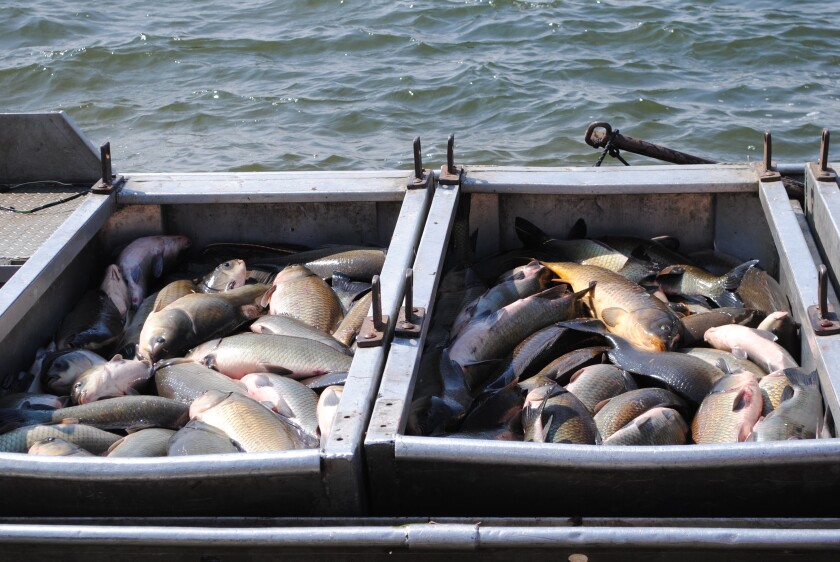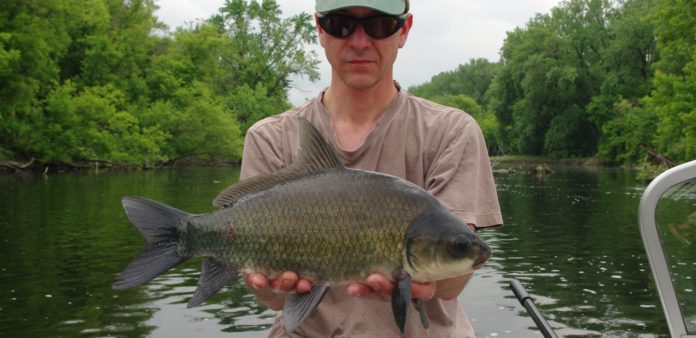Corey Geving was only 6- or 7-years-old when he experienced the kind of thrill that you just never forget, like scoring the winning touchdown in the championship game as time runs out.
He was fishing with his family on an outing to St. Croix State Park when a redhorse sucker latched onto his hook. “It pulled so hard and fought so good,” said Geving. “It was the most exciting thing that happened to me. I couldn’t stop talking about it, into the school year. It made me fall in love with fishing for them,” he told the Tribune.
He’s still talking about it decades later, and more. The Minnesota Department of Natural Resources featured Geving as the presenter for its 53rd edition of the Minnesota Outdoors Skills and Stewardship Series offered online this week.
His topic: Fishing for “rough fish.”
“Kind of the new frontier of angling,” Geving told this writer after his webinar. “This is going to get really big I think in the next few years. I’ve been saying that for years but it gets bigger every year. It’s not a false statement.”
Submitted
He knows what he is saying. Geving, a software developer for the state of Minnesota, is a passionate angler for all fish species. He makes trips to locations as far-flung as Alaska and Arizona to fish for trout. But his forte and driving passion above all else is catching what we call “rough fish” in the waters of his home state, sometimes just down the road from his home in Minneapolis.
He’s the founder of the website
roughfish.org
. It’s on his website that he has witnessed firsthand what he calls the “rediscovery” of pursuing these fish. He originally started the site in 1998 so that he and his friends could list the fish they caught, but interest soon snowballed, he said. He soon had to upgrade the server and can count millions of hits on the site.

Submitted
The term “rough fish” is one of many misconceptions that we need to end, according to Geving. With the exception of carp, the fish species many of us call “rough fish” are native fish with important roles in our ecosystems. They are also tasty table fare, and in many cases, some of the biggest and hardest fighting fish you’ll ever tangle with, he explained.
Tag onto a bowfin, or what many know as a dogfish, and be ready. “Absolute thrill” to catch, he said. They’ll tail walk, leap into the air, and pull far harder than the bigmouth bass that you probably thought you were going to land with the lure you were tossing, he explained.
Minnesota is home to six species of suckers, and some of them are best pursued with the intensity it takes to catch stream trout. Silver suckers can grow to 10 pounds in weight and will stack up in shallow water riffles in the springtime. “As far as I am concerned, it’s one of the can’t miss fishing opportunities that we have in Minnesota,” said Geving on his webinar.

Submitted
Don’t overlook the bigmouth buffalo fish, from which Kandiyohi County gets its name from the Dakota “where the buffalo fish abound.” Recent research shows that these fish can live to 100 plus years, and reach sizes of 60 to 80 pounds.
“That’s gonna put a bend in your rod,” Geving told his webinar audience this week.
As for good table fare, Geving pointed out that people are starting to realize just how delectable the state’s burbot or eelpout are. “Poor man’s lobster” is how many refer to the tasty, cod-like meat. Gevin turns that around: “Lobsters are a poor man’s burbot,” he told the Tribune.
This year’s Minnesota fishing regulations will include the first protection for burbot, a fish that was once routinely (and illegally) discarded outside the fishing shacks of anglers on waters like Lake of the Woods.

Tom Cherveny / West Central Tribune file photo
Don’t overlook sheepshead or whitebass when it comes to fish for the table. More people are discovering how tasty they can be, he explained.
Minnesota is home to a wide variety of fish lumped in the “rough fish” category, and some are very unusual. The American eel breeds in the Sargasso Sea in the Atlantic and for reasons not fully known, the females will migrate up the Mississippi River and some tributaries, including the Minnesota River, before returning to the saltwater.
Shortnose and longnose gar as well as bowfin are prehistoric fish. They can use their air bladders as lungs when oxygen levels in the waters drop.

Submitted
The challenge and fun of catching tasty fish for the table is reason enough for many to take up the sport. There are plenty of other good reasons, starting with a low cost of entry. They can be pursued with basic, hook and line equipment, or fly fishing gear. Expensive electronics and boats are not prerequisites to the sport.
“There is a simplicity to this sport where you can take a pair of sneakers and wade around in a stream and have a blast catching fish,” Geving said.
He also pointed out that rough fish anglers face little competition on the water. They can enjoy the sport in small ponds and waters close to home or in pristine and wild locations.

Tom Cherveny / West Central Tribune file photo
Some of the species are very easy to catch, think bullheads or freshwater drum, making rough fishing a great way for young people to discover fishing.
Yet at the same time, Geving noted that some species of rough fish are very difficult to catch, providing all the challenges that any passionate angler could ask. Blue suckers are on his list of those difficult to catch. Another is the carpsucker, a native fish which is not a carp despite its name. “They make trout look easy as far as fishing for them in clear water and small streams,” said Geving.
One of the big differences between fishing for rough fish and traditional sport species like walleyes is the limited resources available for learning about them. His website,
roughfish,org
, offers a good starting point for those looking to learn about rough fish. Geving also recommends two books: “Fishing for Buffalo” by Minnesota authors Rob Buffler and Tom Dickson, and “American Coarse Angling” by Brook Landis.

Tom Cherveny / West Central Tribune file photo
Credit: Source link






























